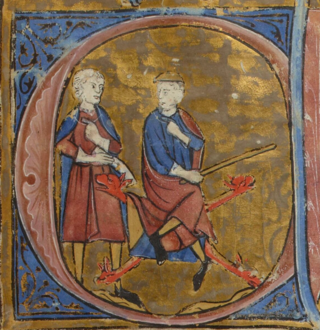The Prix Médicis is a French literary award given each year in November. It was founded in 1958 by Gala Barbisan and Jean-Pierre Giradoux. It is awarded to an author whose "fame does not yet match his talent."

Valentine and Orson is a romance which has been attached to the Carolingian cycle.

Heinrich Khunrath, or Dr. Henricus Khunrath as he was also called, was a German physician, hermetic philosopher, and alchemist. Frances Yates considered him to be a link between the philosophy of John Dee and Rosicrucianism. His name, in the spelling "Henricus Künraht" was used as a pseudonym for the 1670 publisher of the Tractatus Theologico-Politicus of Baruch Spinoza.
Georges Politzer was a French philosopher and Marxist theoretician of Hungarian Jewish origin, affectionately referred to by some as the "red-headed philosopher". He was a native of Oradea, a city in present-day Romania. He was murdered in the Holocaust.

Noël-Antoine Pluche, known as the abbé Pluche, was a French priest. He is now known for his Spectacle de la nature, a most popular work of natural history.

Musaeum Hermeticum is a compendium of alchemical texts first published in German, in Frankfurt, 1625 by Lucas Jennis. Additional material was added for the 1678 Latin edition, which in turn was reprinted in 1749. Its purpose was apparently to supply in a compact form a representative collection of relatively brief and less ancient alchemical writings; it could be regarded as a supplement to those large storehouses of Hermetic learning such as the Theatrum Chemicum, or Jean-Jacques Manget's Bibliotheca Chemica Curiosa. It seemed to represent a distinctive school in Alchemy, less committed to the past and less obscure than the works of older and more traditional alchemical masters.
Donatien Alphonse François de Sade, best known as the Marquis de Sade, was a French aristocrat, revolutionary and author of philosophical and sadomasochistic novels exploring such controversial subjects as rape, bestiality and necrophilia. His works evidence a philosophical mind advocating a materialist philosophy in which Nature dictates absolute freedom, unrestrained by morality, religion or law, with the pursuit of personal pleasure as its foremost principle. Besides novels, he wrote philosophical tracts, novellas, short stories, and a number of plays. Publication, dissemination, and translation of his works have long been hindered by censorship: not until 1983 were his works allowed unfettered distribution in the UK, for instance.

Charles François Dominique de Villers was a French philosopher. He was mainly responsible for translating the philosophy of Immanuel Kant into the French language.
Emmanuel Amand de Mendieta (1907–1976) was a Belgian Benedictine scholar who specialised in the works of St. Basil of Caesarea. Of Belgian aristocratic descent, he attained a brief prominence in the English-speaking world through his conversion to Anglicanism in 1962.

Guillaume le Vinier (c. 1190–1245) was a cleric and trouvère, one of the most prolific composers in the genre. He has left compositions in all the major subgenres of trouvère poetry: chansons d'amour, jeux-partis, a lai, a descort, a chanson de mal mariée and a ballade. He wrote Marian songs and even an imaginary dialogue with a nightingale. His work can be dated with some precision: the poem "En tous tens" is quoted in the Roman de la violette, which was written around 1225.

Bartholomew Laffemas was an economist, born in Beausemblant, France in 1545. He is officially recorded as dying in Paris in 1612. However, it is rumoured that he actually died on September 23, 1611, after falling from his horse. He is known as the first person to write about underconsumption
The Deutsche Theatrum Chemicum is a collection of alchemical texts, predominantly in German translation, which was published in Nuremberg in three volumes by Friedrich Roth-Scholtz (1687–1736), the publisher, printer and bibliographer.

Christopher of Paris was an Italian alchemist active at the end of the fifteenth century and author of a number of treatises influenced by pseudo-Lull. He lived in Venice and is supposed to have had contacts among local glassmakers like Angelo Barovier.
Pierre Desrey de Troyes was a French chronicler, historian, genealogist and translator. Relatively little is known of his life, but his work is of value to historians.

Tripus Aureus or The Golden Tripod is an alchemical book by Michael Maier published in 1618 by Lucas Jennis. It contains three alchemical texts: The "twelve keys" of Basil Valentine, Thomas Norton's Ordinal of Alchemy (1477), and The Testament of Cremer.

The Twelve Keys of Basil Valentine is a widely reproduced alchemical book attributed to Basil Valentine. It was first published in 1599 by Johann Thölde who is likely the book's true author. It is presented as a sequence of alchemical operations encoded allegorically in words, to which images have been added. The first Basil Valentine book to discuss the keys is Ein kurtz summarischer Tractat, von dem grossen Stein der Uralten, 1599.

The Hermetical Triumph: or, The Victorious Philosophical Stone. is an alchemical text published in London in 1723 by P. Hanet. It is subtitled "A Treatise more compleat and more intelligible than any has been yet, concerning The Hermetical Magistery". Its subject matter centres around an early seventeenth century German dialog, The Ancient War of the Knights. A commentary is included.
Louis Charles Achille d'Artois de Bournonville was a French writer, librettist and dramatist.

Jacques-Alphonse Mahul was a French columnist and politician. A liberal activist, he was affiliated with the Carbonari, and was imprisoned for some time at La Force Prison. He participated in the editing of many liberal newspapers such as the Revue encyclopédique.

Pierre-Jean Fabre was a French doctor and alchemist. Born in Castelnaudary, France in 1588, he studied medicine in Montpellier, France. He became a practitioner of the iatrochemical medicine of Paracelsus. Beginning in 1610 he practiced medicine in Castelnaudary. He became famous as a specialist in the plague which was particularly severe in central Europe during the Thirty Years' War. Fabre prescribed chemical medications for the treatment of the plague and was at one time the private physician of King Louis XIII of France.
















